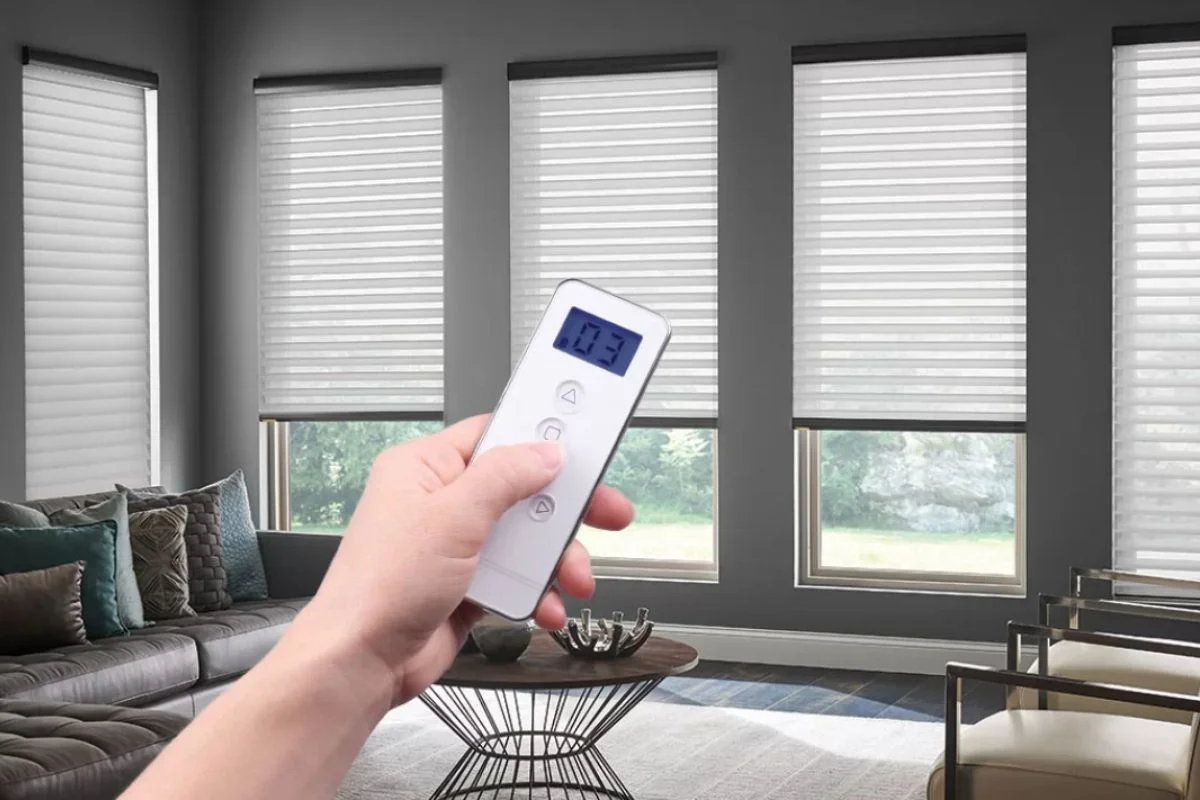
Selecting the ideal smart blinds for your home involves careful consideration of various factors to ensure they meet your needs and seamlessly integrate with your lifestyle. As technology continues to advance, smart blinds offer an array of features designed to enhance convenience, energy efficiency, and style in your living space. However, with so many options available on the market, navigating the selection process can feel overwhelming.
In this section, we’ll explore the key factors you should consider when choosing smart blinds for your home. From understanding compatibility and functionality to assessing design preferences and budget constraints, we’ll provide practical guidance to help you make an informed decision. By considering these factors thoughtfully, you can select smart blinds that not only meet your practical requirements but also complement your home’s aesthetic and contribute to a more comfortable and convenient living environment.
Brief overview of smart blinds technology
Smart blinds technology integrates innovative features such as sensors, connectivity, and automation to revolutionize traditional window treatments. These blinds can be controlled remotely through smartphones, tablets, or voice commands, offering unparalleled convenience and flexibility. By adjusting the blinds’ position based on factors like sunlight, time of day, or user preferences, smart blinds optimize natural light, regulate temperature, and enhance privacy. This technology not only enhances comfort but also promotes energy efficiency by reducing the need for artificial lighting and heating or cooling systems. Additionally, smart blinds can seamlessly integrate with existing smart home ecosystems, allowing users to create customized schedules, routines, and scenes to suit their lifestyle and preferences. Overall, smart blinds represent a futuristic solution that combines functionality, aesthetics, and sustainability in modern home design.
Definition and explanation of smart blinds
Smart blinds are an innovative evolution of traditional window treatments that incorporate advanced technology to enhance convenience, energy efficiency, and comfort within the home. Unlike conventional blinds, which require manual adjustment, smart blinds are equipped with sensors, connectivity features, and automation capabilities, allowing them to be controlled remotely through various devices such as smartphones, tablets, or smart home assistants.
At their core, smart blinds utilize sensors to gather data on environmental factors such as sunlight intensity, temperature, and time of day. This information is then processed to determine the optimal position of the blinds to achieve desired outcomes, such as regulating natural light levels, maintaining comfortable room temperatures, and maximizing energy efficiency.
Connectivity is another key aspect of smart blinds technology, enabling seamless integration with existing smart home ecosystems. This integration allows users to control their blinds remotely from anywhere with an internet connection, as well as to synchronize them with other smart devices and systems within the home.
Automation features further elevate the functionality of smart blinds by enabling them to operate autonomously based on predefined schedules, user preferences, or environmental conditions. For example, smart blinds can be programmed to open gradually in the morning to let in natural light and close automatically in the evening for privacy and insulation.
Benefits of Smart Blinds
Smart blinds offer a multitude of benefits that enhance both the functionality and ambiance of your home. Here are some of the key advantages:
Convenience: With smart blinds, you can effortlessly control your window coverings from anywhere using your smartphone or voice commands. This means no more manual adjustments or struggling with cords, making it easier to achieve the perfect lighting and privacy levels throughout the day.
Energy Efficiency: By automatically adjusting based on factors like sunlight and temperature, smart blinds help regulate the indoor climate of your home. This can lead to reduced reliance on heating and cooling systems, resulting in lower energy bills and a smaller carbon footprint.
Enhanced Privacy and Security: Smart blinds allow you to maintain privacy without sacrificing natural light. You can schedule your blinds to close automatically when you’re away, giving the appearance that someone is home and deterring potential intruders.
UV Protection: By controlling the amount of sunlight that enters your home, smart blinds help protect your furniture, flooring, and artwork from fading due to UV exposure. This can prolong the lifespan of your belongings and save you money on replacements.
Customization and Personalization: With the ability to program schedules and presets, smart blinds enable you to create the perfect ambiance for any occasion. Whether you’re hosting a dinner party, watching a movie, or simply relaxing at home, you can adjust your blinds to suit your mood and activities.
Integration with Smart Home Systems: Smart blinds seamlessly integrate with popular smart home platforms like Amazon Alexa, Google Assistant, and Apple HomeKit, allowing for centralized control and automation of all your connected devices.
Accessibility: Smart blinds make it easier for individuals with mobility issues or disabilities to control their window coverings independently. With just a few taps on a smartphone or a voice command, anyone can adjust the blinds to their preferred position without having to reach or strain themselves.
Factors to Consider When Choosing Smart Blinds
When selecting smart blinds for your home, it’s essential to consider several factors to ensure they meet your needs and preferences. Here are some key considerations:
Compatibility: Before purchasing smart blinds, check compatibility with your existing smart home ecosystem. Ensure they can seamlessly integrate with platforms like Amazon Alexa, Google Assistant, or Apple HomeKit if you plan to control them using voice commands or through a central smart home hub.
Design and Aesthetics: Smart blinds come in various styles, colors, and materials to complement your home decor. Consider the design and aesthetics of the blinds to ensure they enhance the overall look and feel of your living space.
Functionality: Evaluate the features and functionality offered by the smart blinds. Look for options such as remote control, automation, scheduling, and customizable settings to suit your lifestyle and preferences.
Budget: Set a budget for your smart blinds project and explore options within your price range. Consider not only the upfront cost of the blinds but also any additional expenses such as installation, maintenance, and ongoing subscription fees for advanced features.
Installation Process: Determine whether you prefer DIY installation or professional installation services. Some smart blinds are designed for easy installation, while others may require professional assistance, especially if they need to be hardwired or integrated with existing window treatments.
Power Source: Consider the power source required for operating the smart blinds. While some models run on battery power, others may need to be connected to a power outlet or hardwired into your home’s electrical system. Choose the option that best suits your preferences and setup.
Control Options: Decide how you want to control your smart blinds. While most models offer smartphone apps for remote control, some may also support voice commands or physical remote controls. Choose the control option that is most convenient and intuitive for you and your family.
Durability and Warranty: Check the durability and warranty of the smart blinds to ensure they can withstand daily use and provide long-term reliability. Look for products with robust construction and a comprehensive warranty that covers manufacturing defects and malfunctions.
Creative Uses of Smart Blinds
Smart blinds offer more than just light control and privacy; they can also be utilized in creative ways to enhance various aspects of your home environment. Here are some imaginative uses of smart blinds:
Ambiance Creation: Adjusting the position of your smart blinds can instantly change the ambiance of a room. Use them to create different moods throughout the day, such as opening them wide to flood the room with natural light in the morning and closing them partially for a cozy atmosphere in the evening.
Home Theater Enhancement: Transform your living room into a home theater experience by integrating smart blinds with your entertainment system. Lower the blinds automatically when you start a movie to eliminate glare and create a cinema-like setting.
Artwork Showcase: Use smart blinds to control the amount of natural light that reaches your artwork or prized possessions. Adjusting the blinds’ position can highlight specific pieces, protect them from harmful UV rays, and create an art gallery feel in your home.
Plant Care: If you have indoor plants that require specific levels of sunlight, smart blinds can help regulate their exposure. Program the blinds to adjust throughout the day to provide the optimal amount of sunlight for your plants’ health and growth.
Pet Comfort: Create a comfortable environment for your pets by using smart blinds to regulate temperature and sunlight exposure. Keep your furry friends cozy during naptime by closing the blinds to block out excessive heat or glare.
Privacy Enhancement: Beyond traditional privacy benefits, smart blinds can enhance privacy in unique ways. For example, program the blinds in your bedroom to close automatically when you enter for added privacy and relaxation.
Energy Conservation: Maximize energy savings by syncing your smart blinds with your home’s heating and cooling systems. Close the blinds during peak sunlight hours to reduce solar heat gain in the summer, or open them to let in sunlight and warmth during the winter, helping to lower your energy bills.
Seasonal Decor: Embrace the spirit of the seasons by adjusting your smart blinds to complement your seasonal decor. For example, during the holiday season, create a cozy and inviting atmosphere by closing the blinds slightly to showcase twinkling lights and festive decorations.
Installation and Maintenance Tips
Installing and maintaining smart blinds is relatively straightforward, but following some tips can ensure a smooth setup process and keep your blinds operating effectively for years to come. Here are some installation and maintenance tips to consider:
Installation Tips:
Read the Instructions: Before you begin installation, carefully read the manufacturer’s instructions provided with your smart blinds. This will help you understand the specific steps required for your blinds and avoid any potential issues.
Gather the Necessary Tools: Make sure you have all the tools you need for installation, such as a drill, screwdriver, and measuring tape. Having everything on hand will streamline the process and prevent delays.
Measure Twice, Install Once: Accurate measurements are crucial for ensuring your smart blinds fit properly. Double-check the dimensions of your windows before installing the blinds to avoid any fitting problems.
Follow Safety Precautions: If your blinds require drilling or electrical work, follow all safety precautions outlined in the instructions. Use safety goggles, gloves, and other protective gear as needed, and turn off power sources before working with electrical components.
Consider Professional Installation: If you’re unsure about installing the blinds yourself or if they require complex wiring, consider hiring a professional installer. They can ensure the blinds are installed correctly and safely.
Maintenance Tips:
Regular Cleaning: Dust and debris can accumulate on the blinds over time, affecting their appearance and performance. Regularly dust or vacuum the blinds to keep them clean and free of dirt.
Inspect Moving Parts: Periodically inspect the moving parts of the blinds, such as the motor, tracks, and cords, for any signs of wear or damage. Lubricate the mechanisms as needed to ensure smooth operation.
Check Batteries: If your smart blinds are battery-operated, monitor the battery levels regularly and replace them as needed. Low batteries can affect the performance of the blinds and may cause them to operate inconsistently.
Adjust Settings as Needed: Review the settings and schedules programmed into your smart blinds periodically to ensure they align with your current preferences and lifestyle. Make adjustments as needed to optimize energy savings and comfort.
Address Issues Promptly: If you notice any issues with your smart blinds, such as unusual noises, uneven movement, or connectivity problems, address them promptly. Contact the manufacturer for troubleshooting assistance or professional repairs if necessary.
Conclusion
In conclusion, smart blinds represent a remarkable fusion of technology and functionality that can significantly enhance the comfort, convenience, and efficiency of your home. By integrating advanced features such as remote control, automation, and connectivity, these innovative window treatments offer a host of benefits that go beyond traditional blinds.




